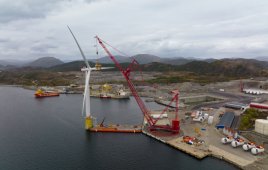By Paul Dvorak, former editor, Windpower Engineering and Development; and Thomas Schock, Team Leader, Cleveland Power of Wind Action Team
Whose side are unelected officials really on: The general public or special interests? The question came to mind recently as the Icebreaker Wind project neared final approval and was halted dead in its tracks by a fatal last-minute requirement.
 Icebreaker Wind, a small pilot farm of six turbines (20.7 MW) planned for Lake Erie, has been in the works for more than 10 years. Over that period, the project team has been gathering funding and meeting state requirements to safeguard fish and wildlife that might be affected by the project. It’s a pilot project so other communities around the Great Lakes might duplicate it and take advantage of the equipment (docks and install vessels) and specialized job skills Icebreaker would teach. Promoters suggest that this project alone would generate $168 million in economic impact over its life.
Icebreaker Wind, a small pilot farm of six turbines (20.7 MW) planned for Lake Erie, has been in the works for more than 10 years. Over that period, the project team has been gathering funding and meeting state requirements to safeguard fish and wildlife that might be affected by the project. It’s a pilot project so other communities around the Great Lakes might duplicate it and take advantage of the equipment (docks and install vessels) and specialized job skills Icebreaker would teach. Promoters suggest that this project alone would generate $168 million in economic impact over its life.
Recently, the Ohio Power Siting Board (OPSB) gave the final go-ahead for the project but with one critical caveat: the turbines could not operate at night for eight months of the year, supposedly out of concern for migrating birds and bats that studies said would be unaffected. This was essentially a poison pill that made the project financially impractical and would thereby kill it.
The caveat, we suspect, was placed in the final “approval” by a former coal and utility-industry lobbyist appointed as the Board Chairman by Ohio Governor Mike DeWine. Other board members seemed surprised when they learned of the late addition and professed to be unaware of it when they voted their approval.
To say the least, we supporters were greatly disheartened after learning of the not-to-operate clause. What do we do now, after many years of hearings, reports, fund raising, scouting fabrication facilities, and the planning approval of 13 other local, state, and federal agencies?
With the million in investments and many jobs on the line, we reached out to the 40 state senators and representatives in the 11 counties of northeast Ohio by a Zoom call. It worked. These representatives then collectively wrote a Letter of Support to Governor DeWine and members of the OPSB pointing out what was being lost and asking them to reconsider that poisonous clause. This was a bipartisan, bicameral effort that was signed by 32 legislators. Another legislator sent his own support letter for Icebreaker. Together, this represented over 80% of the northeast Ohio delegation and 25% of the Ohio General Assembly.

The Icebreaker Wind project is a proposed 20.7-MW demonstration wind farm in Lake Erie that will consist of six 3.45-MW turbines.
Lo and behold, that worked too. The board members reconsidered the clause and removed it. Now Icebreaker has an unfettered go-ahead.
This victory provides a few lessons for renewable energy advocates facing similar obstacles. First, no group is too small to be effective. We worked with a group with about a dozen active members and many more who are less involved. Writing letters and phone calls are not difficult and most everyone can do that. Although the Governor never, to our knowledge, acknowledged the letters and calls we made, he must have heard of them because he encouraged the OPSB to reconsider what they had voted on.
Second, look for allies as we did with state senators and representatives, and suggest their course of action. Determined supporters can rally the local leadership to recognize their own best interests. Don’t be shy. It’s their job to listen to constituents.
Third, money talks, so highlight the worthy investment at stake and what its loss means to the affected communities. In our letters and phone calls we stressed they would never see the million-dollar investments in roads and schools that companies were willing to make and the jobs the project would generate.
Every project like Icebreaker will have opponents, some honest but many less so. Your opponents will be attending related meetings and hearings, and you should be there too. You can also spot some opponents because they are from out of state or funded by shadowy or recently established organizations. Just remember, determined supporters, making their voices heard with good and clear arguments can withstand unfair assaults and win the argument to everyone’s benefit.
Filed Under: Featured





I beleive that some equipment to mitigate risk of bat and bird reducing speed or using frequency that can affetc bat and bird can also e used to reduce collision risk without shutting down the plant can also be used suring the most criticla months of migrating birds and bats. If the demonstration project show few collisions it will help for other projetcs coming